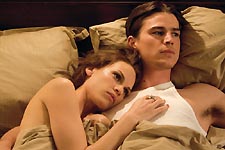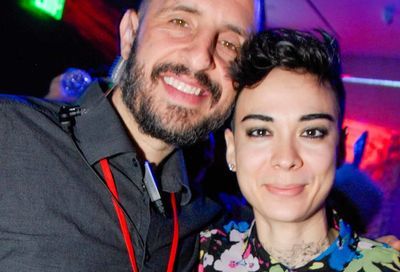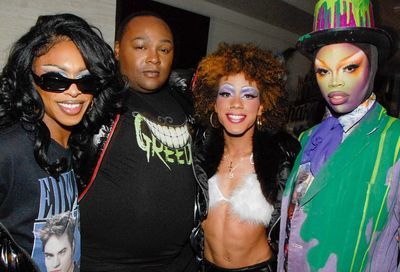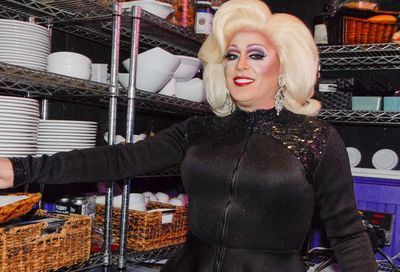Unsolved Misery
There's style in 'The Black Dahlia,' but no substance, as Brian De Palma tosses another bomb onto his stockpile
Vilmos Zsigmond, cinematographer. Dante Ferretti, production designer. Mark Isham, composer. Hilary Swank, actress. These are not film industry names normally associated with cinematic belly flops. Unless…
Unless they’re being led astray by a director who, while considered generally adept at his craft, has forged fearlessly ahead into flop territory more often than most: Brian De Palma.
From the biggest Hollywood nuke of them all (Bonfire of the Vanities) to the virtually unwatchable (Raising Cain), De Palma has served up just as many awful experiences as he has provided good (Carrie, Scarface). He remains a master technician and can construct a visual sequence that can blow your mind and dazzle your eyes — but the basics of clear, concise storytelling all too often just simply elude him. In The Black Dahlia, they don’t just elude him, they run away screaming.
 Black Dahlia’s don’t cry: Swank and Hartnett |
Based on the novel by James Ellroy, which in turn was inspired by one of the most grisly unsolved murders in Hollywood history, The Black Dahlia is forged in the classic noir style, complete with a leaden voice over narration, courtesy Josh Hartnett, who plays Officer Dwight ”Bucky” Bleichert, one of two detectives struggling to solve the horrific murder of a young, hopeful actress named Betty Short (The L Word‘s Mia Kirshner).
Betty is found dumped roadside, sliced in half at the midriff and fully disemboweled. Deep gashes run from the sides of her lips through her cheeks, forming a ghastly grimace. Bucky and his partner, Lee Blanchard (Aaron Eckhart), take it upon themselves to find the murderer. They’d have been better off handing out parking tickets.
Bucky pursues a Betty Short lookalike, a femme fatale named Madeleine Linscott (Hilary Swank), whom he promptly beds in exchange for clues. Lee, meanwhile, trots off on an obsessive, Benzadrine-fueled rampage, in an effort to… in an effort to… well, to be completely honest, I’m not really sure what. It has something to do with the murder and then again, it doesn’t. In the middle of all this stands Kay Lake (Scarlett Johansson), an icy blonde who is carnally beholden to Lee but not-so-secretly yearns for a little Bucky between her loins.
The Black Dahlia is a convoluted, clumsy mess — characters integral to the mystery are suddenly introduced out of the blue, as though their big scenes were left behind on the cutting room floor. By the time the movie wraps up, you’re no better informed than when you walked into the theater. You might as well have spent two hours watching a blank screen.
|
The explanation behind Betty Short’s murder is weak and wilted, like old, moldy lettuce. From what I could tell, the murder is tied to an obsession, but the brutality of the crime, enacted with surgical precision, doesn’t make a bit of sense. Perhaps it’s because of a lurid lesbian-leaning stag film that featured Betty and another actress. Perhaps not. De Palma attempts to connect every dot and in the process makes more of a jumble than if he had left the mystery ”unsolved.”
|
There are two isolated moments where De Palma’s mastery bursts through — the dreamlike, haphazard discovery of Betty’s body as seen by an aerial camera and a gripping sequence in which a detective and his assailant plummet to their deaths — but they only serve as frustrating reminders that somewhere within this stinky garbage a potential great film once lurked.
There isn’t a performance in The Black Dahlia worth noting — at least in positive terms — with the exception of Hartnett, who somehow manages to retain his dignity with a tightly focused, understated performance. Nearly everyone else — Eckhart, Swank and Fiona Shaw as a loony-tunes society matron — is either ragingly over the top or, like Johansson, staggeringly dull.
The movie is overrun by style — Zsigmond’s photography is, as ever, sumptuous, his camera floating as though on a cloud, and Ferretti’s design gorgeously evokes the deco-lavish ’40s, particularly in a lesbian supper club sequence (featuring k.d. lang, no less, in a brief, satisfying musical cameo) — but there is no substance, no emotional contact, no reason for the movie to exist other than for De Palma to toss yet another bomb onto his stockpile.
Support Metro Weekly’s Journalism
These are challenging times for news organizations. And yet it’s crucial we stay active and provide vital resources and information to both our local readers and the world. So won’t you please take a moment and consider supporting Metro Weekly with a membership? For as little as $5 a month, you can help ensure Metro Weekly magazine and MetroWeekly.com remain free, viable resources as we provide the best, most diverse, culturally-resonant LGBTQ coverage in both the D.C. region and around the world. Memberships come with exclusive perks and discounts, your own personal digital delivery of each week’s magazine (and an archive), access to our Member's Lounge when it launches this fall, and exclusive members-only items like Metro Weekly Membership Mugs and Tote Bags! Check out all our membership levels here and please join us today!






















